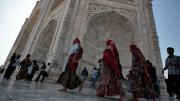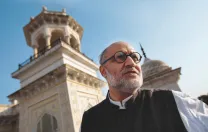Professor of urban design and planning Rahul Mehrotra has been involved with restoring historic palaces, writing a law on historic preservation in Mumbai, and crafting a conservation master plan for the Taj Mahal. Harvard recruited him in part for this expertise, and this academic year, with Noyes professor in architectural theory Michael Hays, he has launched a conservation track for Graduate School of Design (GSD) master’s students.
Conservation, he says, is not the same as preservation, which focuses on protection and repair. Conservation is broader and richer, combining historical integrity and creativity to develop narratives connecting the present with the past. In fact, Mehrotra sees conservation as part of every project: “Even if you go to an empty site, there’s a history there”—natural history. “Nothing is a tabula rasa.”
This broad view makes Harvard’s program unique within the historic conservation field. Most programs focus on the “canons” of conservation, such as the criteria for UNESCO World Heritage Site designation, and the mechanics of conservation. Harvard’s program envisions the subject more broadly, sometimes even challenging whether the canons apply in every context.
It is further enhanced by the rare combination of urban-planning and urban-design programs within one school. Ever since the urban-planning program was transferred from the Harvard Kennedy School to the GSD in 1992, it has been “an uneasy fit,” says Mehrotra, but he and GSD dean Mohsen Mostafavi are working to transform the unusual pairing into an asset: architecture and public policy collaborate instead of clashing.
This melding appears in the design studio that Mehrotra has organized for the past two years, which takes students from the GSD and the schools of business and government to Mumbai during the January break to study a part of the city and make recommendations. (For more on the course, see “Into India,” March-April.) The studio combines principles of conservation with another focus of his teaching: he chairs the department of urban planning and design, and leads a course called “Cities by Design,” which takes as case studies Quito, Detroit, Istanbul, Shanghai, and Berlin, as well as Mumbai. (Students may then choose among these cities for subsequent studio courses that include an on-location segment.)
The recommendations from the first Mumbai studio—which examined a fishing village threatened by its location within the city’s prime business district—were delivered at a February symposium attended by decisionmakers in the government, business, and nongovernmental public-policy sectors. Nobody expressed opposition or outright skepticism; Mehrotra considers this a good sign. Because of his long track record in the city, he says, his students’ ideas may be taken more seriously: “People see me as an insider, not an outsider.”













